树结构的基础部分
二叉树
为什么需要树这种数据结构
数组存储方式的分析
优点:通过下标方式访问元素,速度快。对于有序数组,还可使用二分查找提高检索速度。
缺点:如果要检索具体某个值,或者插入值(按一定顺序)会整体移动,效率较低 [示意图]
画出操作示意图:

链式存储方式的分析
优点:在一定程度上对数组存储方式有优化(比如:插入一个数值节点,只需要将插入节点,链接到链表中即可,删除效率也很好)。
缺点:在进行检索时,效率仍然较低,比如(检索某个值,需要从头节点开始遍历) 【示意图】
操作示意图:

树存储方式的分析
能提高数据存储,读取的效率, 比如利用 二叉排序树(Binary Sort Tree),既可以保证数据的检索速度,同时也可以保证数据的插入,删除,修改的速度。【示意图,后面详讲】
案例**😗* [7, 3, 10, 1, 5, 9, 12]

树示意图
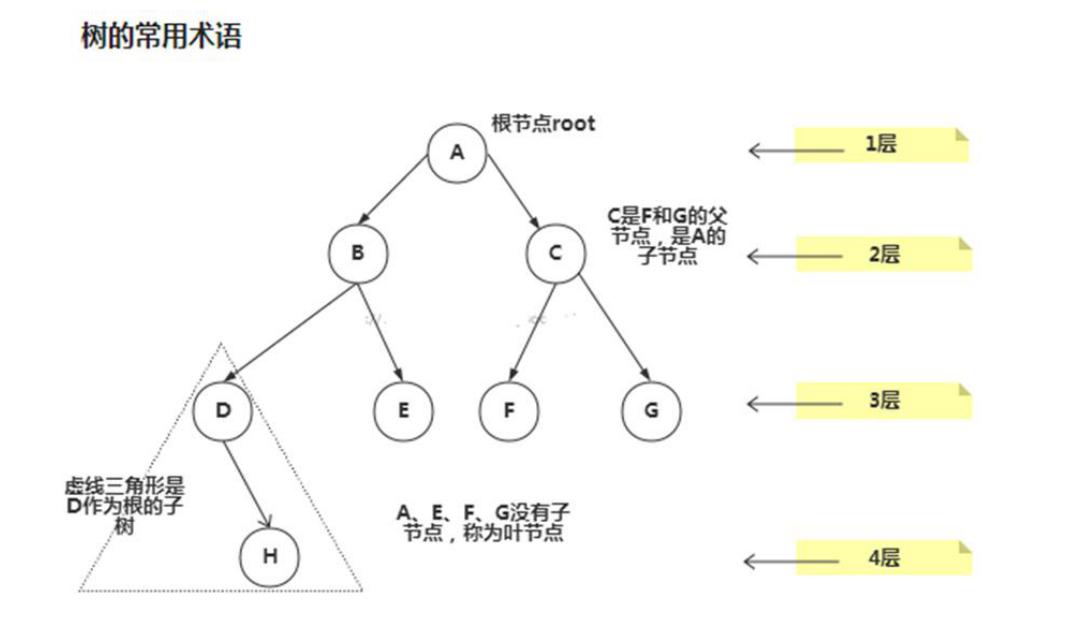
树的常用术语(结合示意图理解):
- 节点
- 根节点
- 父节点
- 子节点
- 叶子节点 (没有子节点的节点)
- 节点的权(节点值)
- 路径(从 root 节点找到该节点的路线)
- 层
- 子树
- 树的高度(最大层数)
- 森林 :多颗子树构成森林
二叉树的概念
- 树有很多种,每个节点最多只能有两个子节点的一种形式称为二叉树。
- 二叉树的子节点分为左节点和右节点
- 示意图
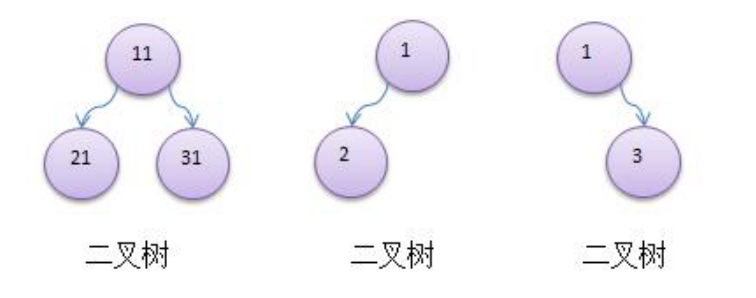
-
如果该二叉树的所有叶子节点都在最后一层,并且结点总数= 2^n -1 , n 为层数,则我们称为满二叉树。
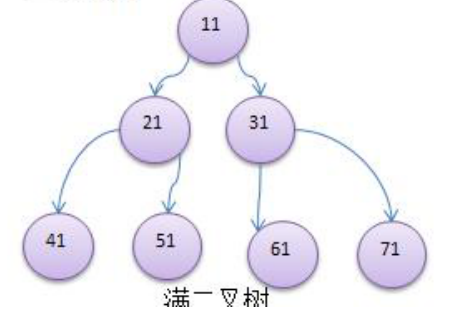
-
如果该二叉树的所有叶子节点都在最后一层或者倒数第二层,而且最后一层的叶子节点在左边连续,倒数第二层的叶子节点在右边连续,我们称为完全二叉树

二叉树遍历的说明
使用前序,中序和后序对下面的二叉树进行遍历.
- 前序遍历: 先输出父节点,再遍历左子树和右子树
- 中序遍历: 先遍历左子树,再输出父节点,再遍历右子树
- 后序遍历: 先遍历左子树,再遍历右子树,最后输出父节点
- 小结: 看输出父节点的顺序,就确定是前序,中序还是后序
二叉树遍历应用实例(前序,中序,后序)
应用实例的说明和思路
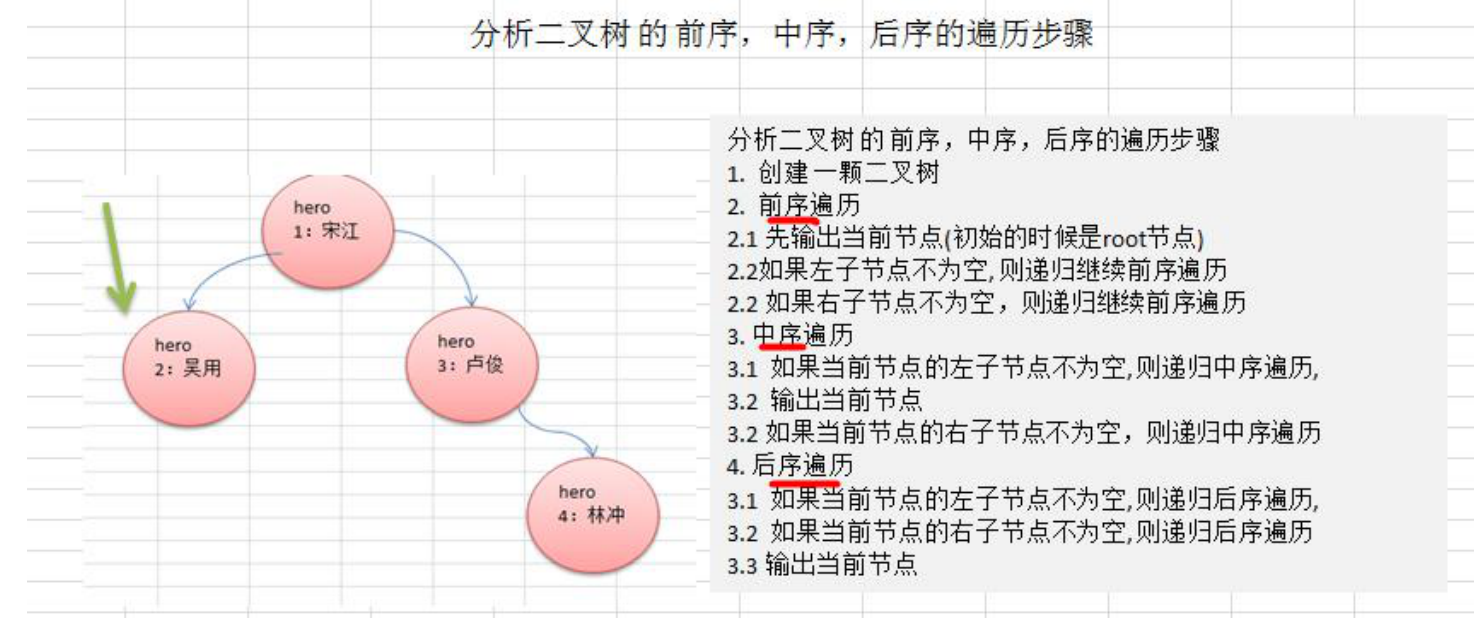
代码实现
package cn.chasing.DataStructure.tree;
import org.junit.Test;
/**
* @author 柴柴快乐每一天
* @create 2021-07-02 7:59 下午
* <p>
* 『Stay hungry, stay foolish. 』
*/
public class BinaryTreeDemo {
@Test
public void test1() {
BinaryTree binaryTree = new BinaryTree();
HeroNode root = new HeroNode(1, "宋江");
HeroNode node2 = new HeroNode(2, "吴用");
HeroNode node3 = new HeroNode(3, "卢俊义");
HeroNode node4 = new HeroNode(4, "林冲");
HeroNode node5 = new HeroNode(5, "关胜");
root.setLeft(node2);
root.setRight(node3);
node3.setRight(node4);
node3.setLeft(node5);
binaryTree.setRoot(root);
System.out.println("前序遍历");
binaryTree.preOrder();
System.out.println("中序遍历");
binaryTree.infixOrder();
System.out.println("后续遍历");
binaryTree.postOrder();
}
}
/**
* BinaryTree 二叉树
*/
class BinaryTree {
private HeroNode root;
public BinaryTree() {
}
public BinaryTree(HeroNode root) {
this.root = root;
}
public HeroNode getRoot() {
return root;
}
public void setRoot(HeroNode root) {
this.root = root;
}
/**
* 前序遍历
*/
public void preOrder() {
if (this.root != null) {
this.root.preOrder();
} else {
System.out.println("二叉树为空,无法遍历");
}
}
/**
* 中序遍历
*/
public void infixOrder() {
if (this.root != null) {
this.root.infixOrder();
} else {
System.out.println("二叉树为空,无法遍历");
}
}
/**
* 后序遍历
*/
public void postOrder() {
if (this.root != null) {
this.root.postOrder();
} else {
System.out.println("二叉树为空,无法遍历");
}
}
}
/**
* HeroNode结点
*/
class HeroNode{
private int no;
private String name;
private HeroNode left;
private HeroNode right;
public HeroNode(int no, String name) {
this.no = no;
this.name = name;
}
@Override
public String toString() {
return "HeroNode{" +
"no=" + no +
", name='" + name + '\'' +
'}';
}
public int getNo() {
return no;
}
public void setNo(int no) {
this.no = no;
}
public String getName() {
return name;
}
public void setName(String name) {
this.name = name;
}
public HeroNode getLeft() {
return left;
}
public void setLeft(HeroNode left) {
this.left = left;
}
public HeroNode getRight() {
return right;
}
public void setRight(HeroNode right) {
this.right = right;
}
/**
* 前序遍历
*/
public void preOrder() {
System.out.println(this); //先输出父节点
// 递归向左子树前序遍历
if (this.left != null) {
this.left.preOrder();
}
// 递归向右子树前序遍历
if (this.right != null) {
this.right.preOrder();
}
}
/**
* 中序遍历
*/
public void infixOrder() {
// 递归向左子树中序遍历
if (this.left != null) {
this.left.infixOrder();
}
// 输出父节点
System.out.println(this);
// 递归右子树中序遍历
if (this.right != null) {
this.right.infixOrder();
}
}
/**
* 后续遍历
*/
public void postOrder() {
if (this.left != null) {
this.left.postOrder();
}
if (this.right != null) {
this.right.postOrder();
}
System.out.println(this);
}
}
二叉树-查找指定节点
要求
-
请编写前序查找,中序查找和后序查找的方法。
-
并分别使用三种查找方式,查找 heroNO = 5 的节点
-
并分析各种查找方式,分别比较了多少次
-
思路分析图解
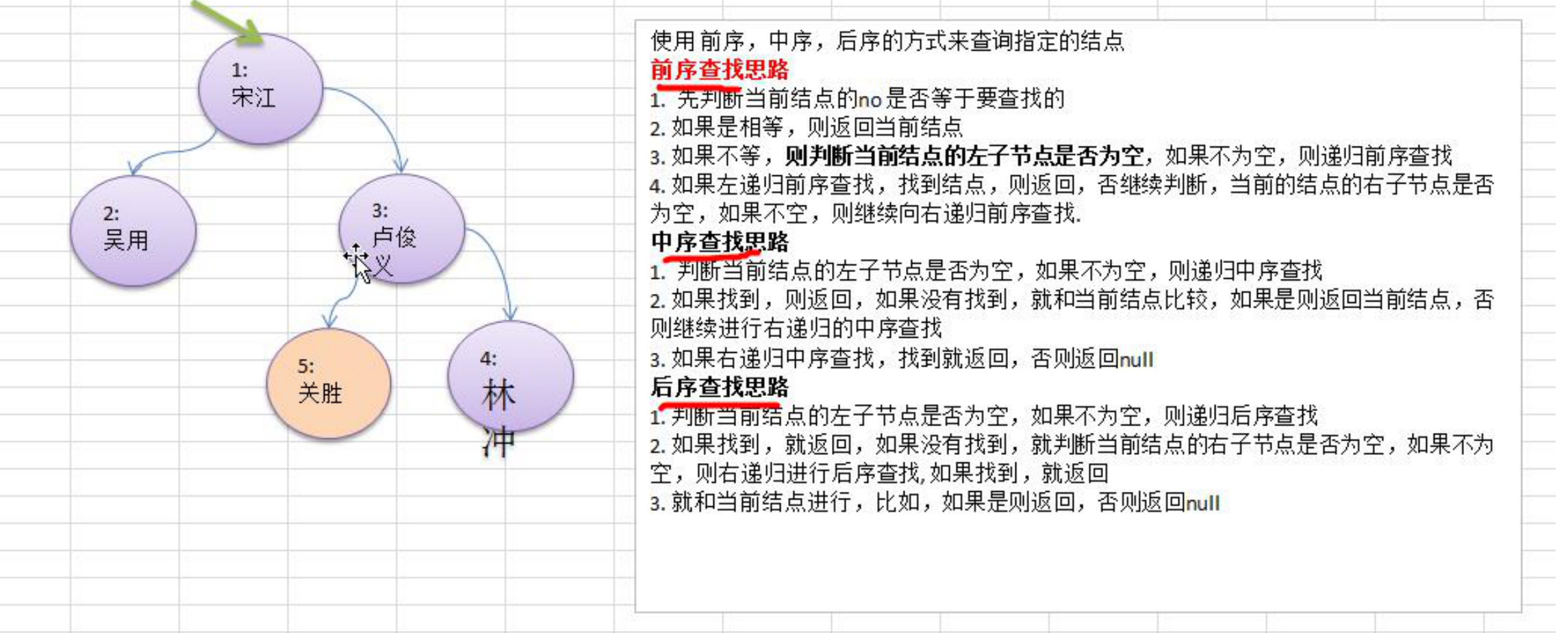
- 代码实现
package cn.chasing.DataStructure.tree;
import org.junit.Before;
import org.junit.Test;
/**
* @author 柴柴快乐每一天
* @create 2021-07-02 7:59 下午
* <p>
* 『Stay hungry, stay foolish. 』
*/
public class BinaryTreeDemo {
BinaryTree binaryTree = new BinaryTree();
HeroNode root = new HeroNode(1, "宋江");
HeroNode node2 = new HeroNode(2, "吴用");
HeroNode node3 = new HeroNode(3, "卢俊义");
HeroNode node4 = new HeroNode(4, "林冲");
HeroNode node5 = new HeroNode(5, "关胜");
@Before
public void before() {
root.setLeft(node2);
root.setRight(node3);
node3.setRight(node4);
node3.setLeft(node5);
binaryTree.setRoot(root);
}
@Test
public void test1() {
System.out.println("前序遍历");
binaryTree.preOrder();
System.out.println("中序遍历");
binaryTree.infixOrder();
System.out.println("后续遍历");
binaryTree.postOrder();
}
@Test
public void test3() {
System.out.println("删除前,前序遍历");
binaryTree.preOrder(); // 1,2,3,5,4
binaryTree.deleteNo(5);
//binaryTree.delNode(3);
System.out.println("删除后,前序遍历");
binaryTree.preOrder(); // 1,2,3,4
}
@Test
public void test2() {
System.out.println("遍历查找");
HeroNode resNode = binaryTree.postOrderSearch(5);
if (resNode != null) {
System.out.printf("找到了,信息为 no=%d name=%s", resNode.getNo(), resNode.getName());
} else {
System.out.printf("没有找到 no = %d 的英雄", 5);
}
}
}
/**
* BinaryTree 二叉树
*/
class BinaryTree {
private HeroNode root;
public BinaryTree() {
}
public BinaryTree(HeroNode root) {
this.root = root;
}
public HeroNode getRoot() {
return root;
}
public void setRoot(HeroNode root) {
this.root = root;
}
/**
* 前序遍历
*/
public void preOrder() {
if (this.root != null) {
this.root.preOrder();
} else {
System.out.println("二叉树为空,无法遍历");
}
}
/**
* 中序遍历
*/
public void infixOrder() {
if (this.root != null) {
this.root.infixOrder();
} else {
System.out.println("二叉树为空,无法遍历");
}
}
/**
* 后序遍历
*/
public void postOrder() {
if (this.root != null) {
this.root.postOrder();
} else {
System.out.println("二叉树为空,无法遍历");
}
}
/**
* 前序遍历查找
* @param no
* @return
*/
public HeroNode preOrderSearch(int no) {
if (this.root != null) {
return this.root.preOrderSearch(no);
} else {
return null;
}
}
/**
* 中序遍历查找
* @param no
* @return
*/
public HeroNode infixOrderSearch(int no) {
if (this.root != null) {
return this.root.infixOrderSearch(no);
} else {
return null;
}
}
/**
* 后序遍历查找
* @param no
* @return
*/
public HeroNode postOrderSearch(int no) {
if (this.root != null) {
return this.root.postOrderSearch(no);
} else {
return null;
}
}
/**
* 删除节点
* @param no
*/
public void deleteNo(int no){
if (this.root != null) {
// 这样才能完成当前节点的比较
if (this.root.getNo() == no) {
this.root = null;
return;
} else {
// 递归进去第一步就是比较当前节点
this.root.delete(no);
}
} else {
System.out.println("this tree is null and cannot delete");
}
}
}
/**
* HeroNode结点
*/
class HeroNode{
private int no;
private String name;
private HeroNode left;
private HeroNode right;
public HeroNode(int no, String name) {
this.no = no;
this.name = name;
}
@Override
public String toString() {
return "HeroNode{" +
"no=" + no +
", name='" + name + '\'' +
'}';
}
public int getNo() {
return no;
}
public void setNo(int no) {
this.no = no;
}
public String getName() {
return name;
}
public void setName(String name) {
this.name = name;
}
public HeroNode getLeft() {
return left;
}
public void setLeft(HeroNode left) {
this.left = left;
}
public HeroNode getRight() {
return right;
}
public void setRight(HeroNode right) {
this.right = right;
}
/**
* 前序遍历
*/
public void preOrder() {
System.out.println(this); //先输出父节点
// 递归向左子树前序遍历
if (this.left != null) {
this.left.preOrder();
}
// 递归向右子树前序遍历
if (this.right != null) {
this.right.preOrder();
}
}
/**
* 中序遍历
*/
public void infixOrder() {
// 递归向左子树中序遍历
if (this.left != null) {
this.left.infixOrder();
}
// 输出父节点
System.out.println(this);
// 递归右子树中序遍历
if (this.right != null) {
this.right.infixOrder();
}
}
/**
* 后续遍历
*/
public void postOrder() {
if (this.left != null) {
this.left.postOrder();
}
if (this.right != null) {
this.right.postOrder();
}
System.out.println(this);
}
/**
* 前序遍历查找
* @param no 查找no
* @return 找到返回该node,没找到返回null
*/
public HeroNode preOrderSearch(int no) {
System.out.println("pre");
if (this.no == no) {
return this;
}
HeroNode resNode = null;
if (this.left != null) {
resNode = this.left.preOrderSearch(no);
}
if (resNode != null) {
return resNode;
}
if (this.right != null) {
resNode = this.right.preOrderSearch(no);
}
return resNode;
}
/**
* 中序遍历查找
* @param no
* @return
*/
public HeroNode infixOrderSearch(int no) {
HeroNode resNode = null;
if (this.left != null) {
resNode = this.left.infixOrderSearch(no);
}
if (resNode != null) {
return resNode;
}
System.out.println("infix");
if (this.no == no) {
return this;
}
if (this.right != null) {
resNode = this.right.infixOrderSearch(no);
}
return resNode;
}
/**
* 后续遍历查找
* @param no
* @return
*/
public HeroNode postOrderSearch(int no) {
HeroNode resNode = null;
if (this.left != null) {
resNode = this.left.postOrderSearch(no);
}
if (resNode != null) {
return resNode;
}
if (this.right != null) {
resNode = this.right.postOrderSearch(no);
}
if (resNode != null) {
return resNode;
}
System.out.println("post");
if (this.no == no) {
return this;
}
return null;
}
//思路
/*
* 1. 因为我们的二叉树是单向的,所以我们是判断当前结点的子结点是否需要删除结点,而不能去判断当前这个结点是不是需要删除结点.
2. 如果当前结点的左子结点不为空,并且左子结点 就是要删除结点,就将this.left = null; 并且就返回(结束递归删除)
3. 如果当前结点的右子结点不为空,并且右子结点 就是要删除结点,就将this.right= null ;并且就返回(结束递归删除)
4. 如果第2和第3步没有删除结点,那么我们就需要向左子树进行递归删除
5. 如果第4步也没有删除结点,则应当向右子树进行递归删除.
*/
/**
* 删除节点
* 1.如果删除的节点是叶子节点,则删除该节点
* 2.如果删除的节点是非叶子节点,则删除该子树
* @param no
*/
public void delete(int no) {
if (this.left != null && this.left.no == no) {
this.left = null;
return;
}
if (this.right != null && this.right.no == no) {
this.right = null;
return;
}
if (this.left != null) {
this.left.delete(no);
}
if (this.right != null) {
this.right.delete(no);
}
}
}
二叉树-删除节点
要求
-
如果删除的节点是叶子节点,则删除该节点
-
如果删除的节点是非叶子节点,则删除该子树.尚硅谷 Java 数据结构和算法
-
测试,删除掉 5 号叶子节点 和 3 号子树.
-
完成删除思路分析
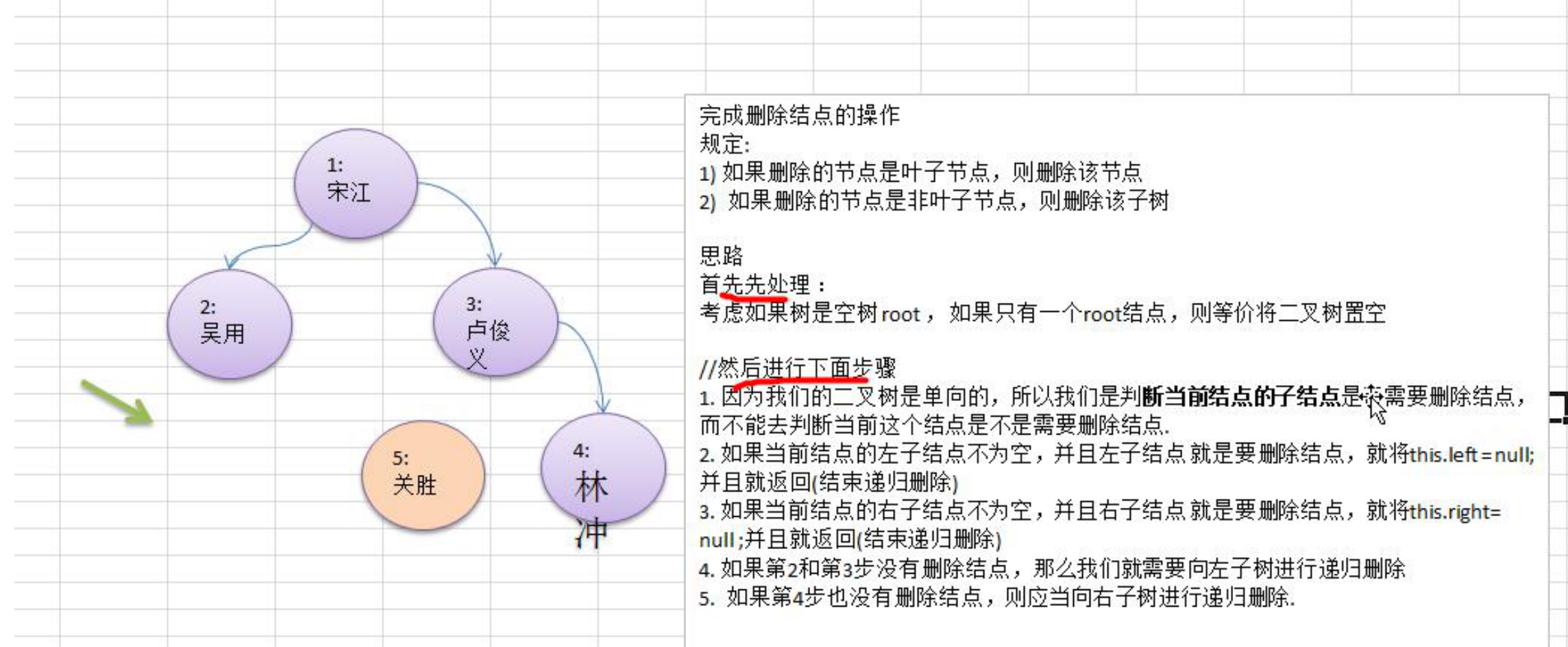
- 代码实现
同上
顺序存储二叉树
顺序存储二叉树的概念
基本说明
从数据存储来看,数组存储方式和树的存储方式可以相互转换,即数组可以转换成树,树也可以转换成数组,看右面的示意图。

要求:
-
右图的二叉树的结点,要求以数组的方式来存放 arr : [1, 2, 3, 4, 5, 6, 6]
-
要求在遍历数组 arr 时,仍然可以以前序遍历,中序遍历和后序遍历的方式完成结点的遍历
顺序存储二叉树的特点:
-
顺序二叉树通常只考虑完全二叉树
-
第 n 个元素的左子节点为 2 * n + 1
-
第 n 个元素的右子节点为 2 * n + 2
-
第 n 个元素的父节点为 (n-1) / 2
-
n : 表示二叉树中的第几个元素(按 0 开始编号如图所示)
顺序存储二叉树遍历
需求: 给你一个数组 {1,2,3,4,5,6,7},要求以二叉树前序遍历的方式进行遍历。 前序遍历的结果应当为 1,2,4,5,3,6,7
代码实现
package cn.chasing.DataStructure.tree;
import org.junit.Test;
/**
* @author 柴柴快乐每一天
* @create 2021-07-06 7:02 下午
* <p>
* 『Stay hungry, stay foolish. 』
*/
public class ArrBinaryTreeDemo {
@Test
public void test() {
int[] arr = { 1, 2, 3, 4, 5, 6, 7 };
//创建一个 ArrBinaryTree
ArrBinaryTree arrBinaryTree = new ArrBinaryTree(arr);
arrBinaryTree.preOrder(); // 1,2,4,5,3,6,7
}
}
class ArrBinaryTree {
private int[] arr;
public ArrBinaryTree(int[] arr) {
this.arr = arr;
}
public void preOrder() {
this.preOrder(0);
}
/**
* 编写一个方法,完成顺序存储二叉树的前序遍历
* @param index 数组的下标
*/
public void preOrder(int index) {
if (arr == null || arr.length == 0) {
System.out.println("数组为空");
}
System.out.println(arr[index]);
// 向左递归遍历
if ((index*2+1) < arr.length) {
preOrder(index*2+1);
}
// 向右递归遍历
if ((index*2+2) < arr.length) {
preOrder(index*2+2);
}
}
}
课后练习
完成对数组以二叉树中序,后序遍历方式的代码.
线索化二叉树
先看一个问题
将数列 {1, 3, 6, 8, 10, 14 } 构建成一颗二叉树. n+1=7
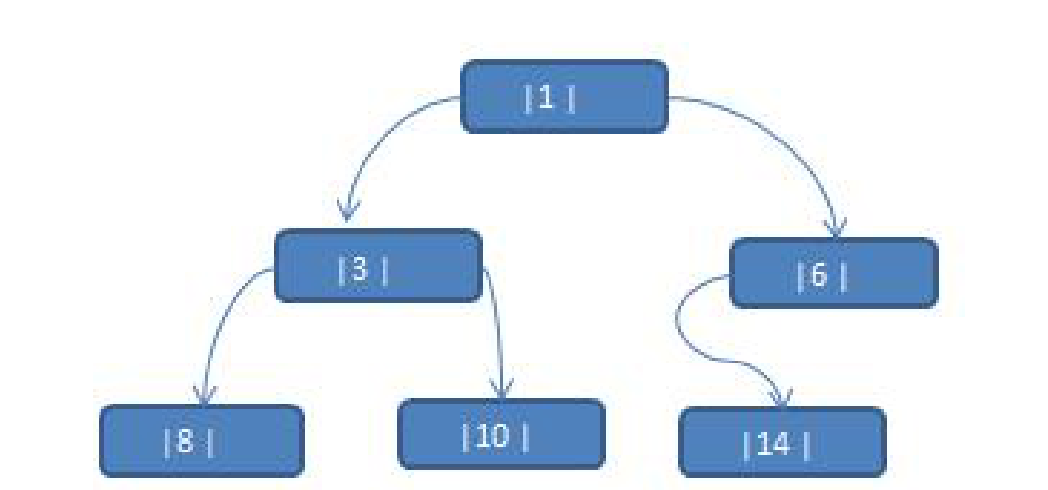
问题分析:
-
当我们对上面的二叉树进行中序遍历时,数列为 {8, 3, 10, 1, 6, 14 }
-
但是 6, 8, 10, 14 这几个节点的 左右指针,并没有完全的利用上.
-
如果我们希望充分的利用 各个节点的左右指针, 让各个节点可以指向自己的前后节点,怎么办?
-
解决方案-线索二叉树
线索二叉树基本介绍
-
n 个结点的二叉链表中含有 n+1 【公式 2n-(n-1)=n+1】 个空指针域。利用二叉链表中的空指针域,存放指向该结点在某种遍历次序下的前驱和后继结点的指针(这种附加的指针称为"线索")
-
这种加上了线索的二叉链表称为线索链表,相应的二叉树称为线索二叉树(Threaded BinaryTree)。根据线索性质的不同,线索二叉树可分为前序线索二叉树、中序线索二叉树和后序线索二叉树三种
-
一个结点的前一个结点,称为前驱结点
-
一个结点的后一个结点,称为后继结点
线索二叉树应用案例
应用案例说明:
将下面的二叉树,进行中序线索二叉树。中序遍历的数列为 {8, 3, 10, 1, 14, 6}
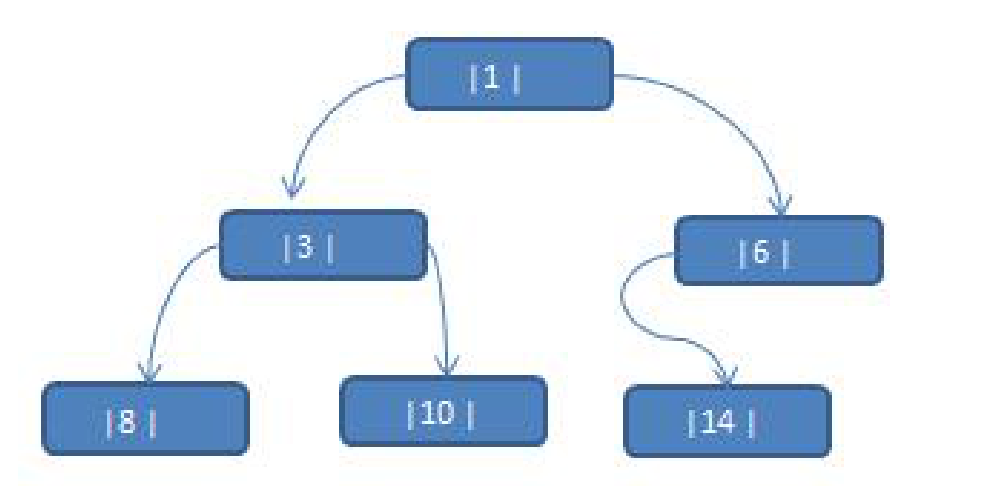
思路分析
中序遍历的结果:{8, 3, 10, 1, 14, 6}

当线索化二叉树后,Node 节点的 属性 left 和 right ,有如下情况:
-
left 指向的是左子树,也可能是指向的前驱节点. 比如 ① 节点 left 指向的左子树, 而 ⑩ 节点的 left 指向的就是前驱节点.
-
right 指向的是右子树,也可能是指向后继节点,比如 ① 节点 right 指向的是右子树,而⑩ 节点的 right 指向的是后继节点.
遍历线索化二叉树
-
说明:对前面的中序线索化的二叉树, 进行遍历
-
分析:因为线索化后,各个结点指向有变化,因此原来的遍历方式不能使用,这时需要使用新的方式遍历线索化二叉树,各个节点可以通过线型方式遍历,因此无需使用递归方式,这样也提高了遍历的效率。 遍历的次序应当和中序遍历保持一致。
代码实现
package cn.chasing.DataStructure.tree;
import org.junit.Test;
/**
* @author 柴柴快乐每一天
* @create 2021-07-06 9:43 下午
* <p>
* 『Stay hungry, stay foolish. 』
*/
public class ThreadedBinaryTreeDemo {
@Test
public void test() {
//测试一把中序线索二叉树的功能
THeroNode root = new THeroNode(1, "tom");
THeroNode node2 = new THeroNode(3, "jack");
THeroNode node3 = new THeroNode(6, "smith");
THeroNode node4 = new THeroNode(8, "mary");
THeroNode node5 = new THeroNode(10, "king");
THeroNode node6 = new THeroNode(14, "dim");
//二叉树,后面我们要递归创建, 现在简单处理使用手动创建
root.setLeft(node2);
root.setRight(node3);
node2.setLeft(node4);
node2.setRight(node5);
node3.setLeft(node6);
//测试中序线索化
ThreadedBinaryTree threadedBinaryTree = new ThreadedBinaryTree();
threadedBinaryTree.setRoot(root);
threadedBinaryTree.threadedNodes();
//测试: 以10号节点测试
THeroNode leftNode = node5.getLeft();
THeroNode rightNode = node5.getRight();
System.out.println("10号结点的前驱结点是 =" + leftNode); //3
System.out.println("10号结点的后继结点是=" + rightNode); //1
//当线索化二叉树后,能在使用原来的遍历方法
//threadedBinaryTree.infixOrder();
System.out.println("使用线索化的方式遍历 线索化二叉树");
threadedBinaryTree.threadedList(); // 8, 3, 10, 1, 14, 6
}
}
/**
* ThreadedBinaryTree 二叉树
*/
class ThreadedBinaryTree {
private THeroNode root;
//为了实现线索化,需要创建要给指向当前结点的前驱结点的指针
//在递归进行线索化时,pre 总是保留前一个结点
private THeroNode pre = null;
//遍历线索化二叉树的方法
public void threadedList() {
//定义一个变量,存储当前遍历的结点,从root开始
THeroNode node = root;
while (node != null) {
//循环的找到leftType == 1的结点,第一个找到就是8结点
//后面随着遍历而变化,因为当leftType==1时,说明该结点是按照线索化
//处理后的有效结点
while (node.getLeftType() == 0) {
node = node.getLeft();
}
System.out.println(node);
while (node.getRightType() == 1) {
node = node.getRight();
System.out.println(node);
}
node = node.getRight();
}
}
public void threadedNodes() {
this.threadedNodes(root);
}
/**
* 编写对二叉树进行中序线索化的方法
* @param node 就是当前需要线索化的结点
*/
public void threadedNodes(THeroNode node) {
//如果node==null, 不能线索化
if (node == null) {
return;
}
// 线索化左子树
threadedNodes(node.getLeft());
// 线索化当前节点
// 处理当前节点的前驱节点
if (node.getLeft() == null) {
node.setLeft(pre);
node.setLeftType(1);
// 以8为例,pre == null, leftType == 1
}
// 处理当前节点的后继节点
// 递归回上一层了
if (pre != null && pre.getRight() == null) {
pre.setRight(node);
pre.setRightType(1);
}
//!!! 每处理一个结点后,让当前结点是下一个结点的前驱结点
pre = node;
// 线索化右子树
threadedNodes(node.getRight());
}
public ThreadedBinaryTree() {
}
public ThreadedBinaryTree(THeroNode root) {
this.root = root;
}
public THeroNode getRoot() {
return root;
}
public void setRoot(THeroNode root) {
this.root = root;
}
/**
* 前序遍历
*/
public void preOrder() {
if (this.root != null) {
this.root.preOrder();
} else {
System.out.println("二叉树为空,无法遍历");
}
}
/**
* 中序遍历
*/
public void infixOrder() {
if (this.root != null) {
this.root.infixOrder();
} else {
System.out.println("二叉树为空,无法遍历");
}
}
/**
* 后序遍历
*/
public void postOrder() {
if (this.root != null) {
this.root.postOrder();
} else {
System.out.println("二叉树为空,无法遍历");
}
}
/**
* 前序遍历查找
* @param no
* @return
*/
public THeroNode preOrderSearch(int no) {
if (this.root != null) {
return this.root.preOrderSearch(no);
} else {
return null;
}
}
/**
* 中序遍历查找
* @param no
* @return
*/
public THeroNode infixOrderSearch(int no) {
if (this.root != null) {
return this.root.infixOrderSearch(no);
} else {
return null;
}
}
/**
* 后序遍历查找
* @param no
* @return
*/
public THeroNode postOrderSearch(int no) {
if (this.root != null) {
return this.root.postOrderSearch(no);
} else {
return null;
}
}
/**
* 删除节点
* @param no
*/
public void deleteNo(int no){
if (this.root != null) {
// 这样才能完成当前节点的比较
if (this.root.getNo() == no) {
this.root = null;
return;
} else {
// 递归进去第一步就是比较当前节点
this.root.delete(no);
}
} else {
System.out.println("this tree is null and cannot delete");
}
}
}
/**
* THeroNode结点
*/
class THeroNode{
private int no;
private String name;
private THeroNode left;
private THeroNode right;
//说明
//1. 如果leftType == 0 表示指向的是左子树, 如果 1 则表示指向前驱结点
//2. 如果rightType == 0 表示指向是右子树, 如果 1表示指向后继结点
private int leftType;
private int rightType;
public int getLeftType() {
return leftType;
}
public void setLeftType(int leftType) {
this.leftType = leftType;
}
public int getRightType() {
return rightType;
}
public void setRightType(int rightType) {
this.rightType = rightType;
}
public THeroNode(int no, String name) {
this.no = no;
this.name = name;
}
@Override
public String toString() {
return "THeroNode{" +
"no=" + no +
", name='" + name + '\'' +
'}';
}
public int getNo() {
return no;
}
public void setNo(int no) {
this.no = no;
}
public String getName() {
return name;
}
public void setName(String name) {
this.name = name;
}
public THeroNode getLeft() {
return left;
}
public void setLeft(THeroNode left) {
this.left = left;
}
public THeroNode getRight() {
return right;
}
public void setRight(THeroNode right) {
this.right = right;
}
/**
* 前序遍历
*/
public void preOrder() {
System.out.println(this); //先输出父节点
// 递归向左子树前序遍历
if (this.left != null) {
this.left.preOrder();
}
// 递归向右子树前序遍历
if (this.right != null) {
this.right.preOrder();
}
}
/**
* 中序遍历
*/
public void infixOrder() {
// 递归向左子树中序遍历
if (this.left != null) {
this.left.infixOrder();
}
// 输出父节点
System.out.println(this);
// 递归右子树中序遍历
if (this.right != null) {
this.right.infixOrder();
}
}
/**
* 后续遍历
*/
public void postOrder() {
if (this.left != null) {
this.left.postOrder();
}
if (this.right != null) {
this.right.postOrder();
}
System.out.println(this);
}
/**
* 前序遍历查找
* @param no 查找no
* @return 找到返回该node,没找到返回null
*/
public THeroNode preOrderSearch(int no) {
System.out.println("pre");
if (this.no == no) {
return this;
}
THeroNode resNode = null;
if (this.left != null) {
resNode = this.left.preOrderSearch(no);
}
if (resNode != null) {
return resNode;
}
if (this.right != null) {
resNode = this.right.preOrderSearch(no);
}
return resNode;
}
/**
* 中序遍历查找
* @param no
* @return
*/
public THeroNode infixOrderSearch(int no) {
THeroNode resNode = null;
if (this.left != null) {
resNode = this.left.infixOrderSearch(no);
}
if (resNode != null) {
return resNode;
}
System.out.println("infix");
if (this.no == no) {
return this;
}
if (this.right != null) {
resNode = this.right.infixOrderSearch(no);
}
return resNode;
}
/**
* 后续遍历查找
* @param no
* @return
*/
public THeroNode postOrderSearch(int no) {
THeroNode resNode = null;
if (this.left != null) {
resNode = this.left.postOrderSearch(no);
}
if (resNode != null) {
return resNode;
}
if (this.right != null) {
resNode = this.right.postOrderSearch(no);
}
if (resNode != null) {
return resNode;
}
System.out.println("post");
if (this.no == no) {
return this;
}
return null;
}
//思路
/*
* 1. 因为我们的二叉树是单向的,所以我们是判断当前结点的子结点是否需要删除结点,而不能去判断当前这个结点是不是需要删除结点.
2. 如果当前结点的左子结点不为空,并且左子结点 就是要删除结点,就将this.left = null; 并且就返回(结束递归删除)
3. 如果当前结点的右子结点不为空,并且右子结点 就是要删除结点,就将this.right= null ;并且就返回(结束递归删除)
4. 如果第2和第3步没有删除结点,那么我们就需要向左子树进行递归删除
5. 如果第4步也没有删除结点,则应当向右子树进行递归删除.
*/
/**
* 删除节点
* 1.如果删除的节点是叶子节点,则删除该节点
* 2.如果删除的节点是非叶子节点,则删除该子树
* @param no
*/
public void delete(int no) {
if (this.left != null && this.left.no == no) {
this.left = null;
return;
}
if (this.right != null && this.right.no == no) {
this.right = null;
return;
}
if (this.left != null) {
this.left.delete(no);
}
if (this.right != null) {
this.right.delete(no);
}
}
}
线索化二叉树的课后作业:
前序线索化二叉树和后序线索化二叉树的分析思路类似






















 3244
3244











 被折叠的 条评论
为什么被折叠?
被折叠的 条评论
为什么被折叠?








